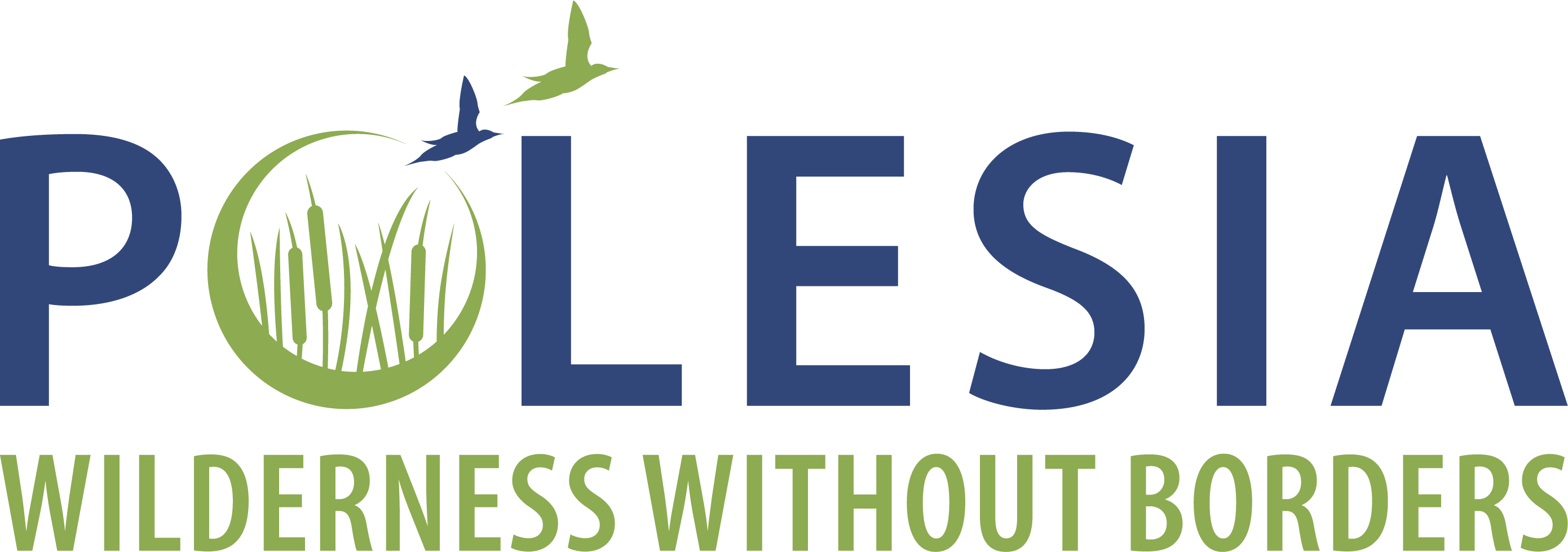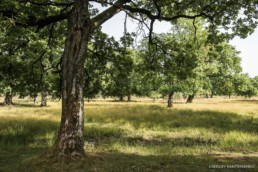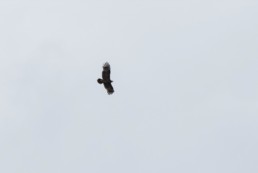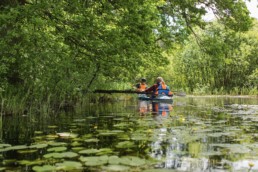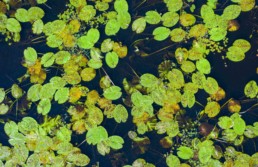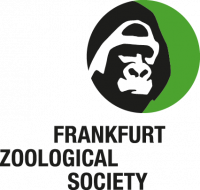A New National Park for Polesia: Pushcha Radzivila
A New National Park for Polesia: Pushcha Radzivila
Polesia’s Pushcha Radzivila National Park secures better protection for wildlife and habitats, improves protected area connectivity, and brings sustainable development opportunities for local communities.
On the first day of 2022 the President of Ukraine signed a decree officially creating the new Pushcha Radzivila National Park. The Ukrainian Society for the Protection of Birds (USPB), as part of the Polesia – Wilderness without borders project, played a significant role in the creation of the new national park.
The park covers 24,265 hectares in Ukraine’s Rivne region. Together with protected areas in neighbouring Belarus, it forms one of the largest natural complexes of bogs and transitional mires in Europe. The area holds old-growth European spruce forests and a majestic 1,300 year-old veteran oak that measures 8 metres around the base of its trunk. Picturesque lakes and wilderness offer significant tourism development opportunities. These water bodies, together with the many swamps and wetlands in the area, are a vital water store for Polesia and Ukraine as a whole. These rare natural habitats also store massive amounts of carbon. Pushcha Radzivila forms part of the Pripyat basin playing a hydro-regulatory role for this mighty river which is the lifeblood of the Polesia region.

A central aim of our work is to increase the protection of these high conservation value areas. “Field experts identify and map primary forests and other high conservation value forests, as well as important sites for rare birds and mammals that lie beyond the boundaries of existing protected areas in order to apply for better protection for these sites”, explains USPB’s Olga Yaremchenko, who leads these efforts in Ukraine.
The presence of key species helps to identify important conservation areas – for example lynx, Greater Spotted Eagle and Black Grouse. Yaremchenko also emphasises that “a key component of our success in creating the Pushcha Radzivila National Park is the engagement of local communities who live nearby and understand the importance of nature conservation as the basis of a healthy life”. Thanks to the persistent support and lobbying of the communities, Rivne region managed to expand its protected area network, and thus increase the protection of Polesia.

In Pushcha Radzivila scientists have counted more than 450 species of plants and 230 species of animals, including 39 nationally endangered species. Grey Cranes and Black Grouse occur in the bogs and mires of the park. The protected area also harbours beavers, otters, lynx, moose, and almost a dozen species of bats.
Connectivity between the protected area network is enhanced – the park borders the Rivnenskyi Nature Reserve in Ukraine and Belarus’s Almany Mires Reserve in the north. The new park will thus also strengthen the protection of important wetlands in Rivnenskyi such as Perebrody Peatlands and Syra Pogonia Bog Ramsar sites.
Article written by Zanne Labuschagne, communications coordinator at FZS. Top image shows oak forests in Pushcha Radzivila National Park. Photo credit: Sergey Kantsyrenko
The project “Polesia – Wilderness Without Borders” is part of the Endangered Landscapes & Seascapes Programme and is funded by Arcadia. The project is coordinated by Frankfurt Zoological Society (FZS).
Wins for Polesia in 2021
Wins for Polesia in 2021
More than 10,000 hectares of the landscape gains better protection. Camera traps help uncover the area’s incredible wildlife, while local communities come together to protect it.
Bigger and better protection
The highlight of the year was by far the 10,000 hectare expansion of Almany Mires Nature Reserve in Belarus. The reserve now spans over 104,000 hectares (about the size of Hong Kong). Europe’s largest intact transition mire is found here. The area provides crucial habitat for globally threatened wildlife. This result hinged on efforts by local NGOs, and the Belarusian Ministry of Environment and National Academy of Sciences.
Better protection for the area was also achieved. Clear-cut logging is now prohibited across the whole reserve. Felling within the core zone is also no longer allowed, and a ban on hunting during the first half of May is in place.
In Ukraine a total of 640 hectares was granted an official protection status this year. Further expansions and the creation of a new national park in Ukraine are still in the pipeline.
Read more about the the next generation of protected areas in Ukrainian Polesia.

Restoring landscapes
I am text block. Click edit button to change this text. Lorem ipsum dolor sit amet, consectetur adipiscing elit. Ut elit tellus, luctus nec ullamcorper mattis, pulvinar dapibus leo.
Watch FZS Belarus Programme Leader Viktar Fenchuk explain our approach:
Wildlife studies guide conservation
Large mammals
Across Polesia we continue to study wildlife at an unprecedented scale. The project deployed three hundred camera traps across 600,000 hectares of key protected areas in Ukraine and Belarus. This data feeds into the most extensive and systematic camera trap survey attempted in the Chernobyl Exclusion Zone yet. Here – as a side effect of a terrible tragedy – nature has space. Data from the area will act as a baseline to assess wildlife presence and connectivity across Polesia to guide conservation.
The camera traps also provide fantastic images of European wildlife: herds of Przewalski’s horses; a close-up view of elusive lynx; and glimpses of wolf packs moving through the woods.
Greater Spotted Eagle
Greater Spotted Eagles from different populations migrate to different areas during winter. Males and females also differ in migration behavior. The results of a study co-authored by Dr Valery Dombrovsky and Dr Adham Ashton-Butt suggest that this migration behavior could worsen population declines.
The study included data from eagles tagged in Polesia. Belarusian breeding males mainly migrate to Africa and females to Europe. Threats faced by the birds, as well as the health of the wetlands they winter in, differ between Europe and Africa. This might already have led to sex-biased survival rates, and is likely to continue to do so in the future if wetlands in Africa become degraded or see more severe climate change impacts.
An imbalance between the number of male and female eagles could increase the chance of them breeding with Lesser Spotted Eagles. The latter are closely-related and more common. This would increase the risk of extinction of the vulnerable Greater Spotted Eagle.
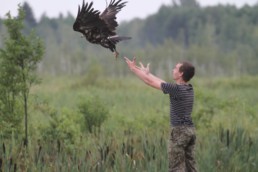
Acoustic monitoring
We can now identify wildlife calls using a custom built-classifier. Since 2019 we have used acoustic monitoring to survey bats, birds, bush crickets and mammals. The approach is non-invasive, cost-effective, and allows simultaneous data collection from different taxa. Using this tool we can collect huge amounts of data in a relatively small amount of time, compared to conventional survey methods.
In 2021 acoustic recorders at 180 locations in Polesia generated millions of recordings. Classifying these recordings manually would be a near impossible task. To this end, the British Trust for Ornithology developed a machine learning algorithm to help sort recordings. The tool sifts out and identifies calls made by wildlife, separating them from other noises like wind and rain.
Sixteen species of bats have been surveyed so far and hundreds of thousands of recordings have been ascribed to species groups. The acoustic classifier is part of a larger European project to survey wildlife using acoustic monitoring.
Guardians of Polesia continue to grow
The ‘caretaker’ groups who volunteer their time to protect and promote nature in Polesia have more than doubled in Belarus alone. There are now over 260 people involved within 18 groups in Belarus and Ukraine. The pandemic continues to hinder some of their activities. Despite this, the groups held ten field camps (for example to collect litter), and 40 environmental education seminars. In Ukraine, new eco-trails are in place, and various lectures and birding seminars were held in both countries.
Polesia on TV
2021 saw some good coverage of the project. The German-French TV broadcaster ARTE carried out a filming trip and produced a feature ‘ARTE RE: Saving Europe’s Amazon. The project was also featured in the ARD series ‘Das große Artensterben’. A documentary about Polesia is now available to watch across the globe on the Waterbear Network.
Supporting Polesia’s protected areas
Four protected areas now have management plans in place, and a training course including over 20 modules is available for Ukrainian protected areas. Protected areas also received equipment, like GPSs, office equipment, weather stations and motorbikes.

Article written by Zanne Labuschagne, communications coordinator at FZS. Top image shows the vast Almany Mire Reserve. Photo credit: Viktar Fenchuk
I am text block. Click edit button to change this text. Lorem ipsum dolor sit amet, consectetur adipiscing elit. Ut elit tellus, luctus nec ullamcorper mattis, pulvinar dapibus leo.
The project “Polesia – Wilderness Without Borders” is part of the Endangered Landscapes & Seascapes Programme and is funded by Arcadia. The project is coordinated by Frankfurt Zoological Society (FZS).
Endangered eagle migration patterns key to their conservation
Endangered eagle migration patterns key to their conservation
The Greater Spotted Eagle is in trouble. Almost extinct in western Europe, Polesia is a stronghold for the critically endangered birds. Roughly 16% of the continent’s population is found in Belarus and 4% in Ukraine. Yet, even in Polesia’s vast network of forests and wetlands, numbers are dropping. Only in the Chernobyl Exclusion Zone has the population increased in the last 20 years.
Why are we seeing these trends, and what could they be telling us about the health of habitat for the eagles? How does human disturbance influence these birds? Which areas are most favourable for them? We are looking for answers as part of our biodiversity monitoring activities within the ‘Polesia – Wilderness without borders’ project, funded by the Endangered Landscapes Programme.


New study uncovers eagle movements
A new study analysed tracking data from 28 adult Greater Spotted Eagles to see where the birds migrated to in winter. The paper, co-authored by Dr Valery Dombrovsky and Dr Adham Ashton-Butt from the project, included data from eagles tagged in Polesia. Wintering grounds – and the health and protection status of these areas – could be an important piece of the puzzle to conserve these precious birds.
Although wintering sites for Greater Spotted Eagles were relatively well known in Europe, eagles had also been sighted in the Middle East and Africa and it was not understood whether eagles from different breeding populations across Europe migrated to different areas. By tagging individuals from different breeding populations the study uncovered the extent of the Greater Spotted Eagle’s wintering range and how it differs between populations and sexes.
The eagles tagged in Belarus spent their winters in Southeast Europe, the Middle East or Africa. Males are more likely to winter further south than females – the majority of the male eagles from Belarus wintered within a narrow belt in South Sudan and Ethiopia. Females headed to the wetlands along the coast of southern Greece and Turkey. The winter grounds in southern Europe tend to be within a small number of protected areas – locations that the study indicates are crucial for the species. Only two of the 12 African sites are protected, both within the same national park.

Greater Spotted Eagles reliance on ecologically intact wetlands hints at one of the mechanisms of decline of this species, as the majority of wetlands in Southern Europe have been destroyed or degraded, with over 63% of Greece’s wetlands lost between 1950 and 1985. “The number of individuals wintering in a small area indicates that their wintering habitats may have been squeezed into fewer and fewer suitable locations”, explains Dr Adham Ashton-Butt from the British Trust for Ornithology.
The finding that Belarusian breeding males mainly migrate to Africa and Females to Europe could impact efforts to conserve Greater Spotted Eagles. The threats faced by the birds as well as the health of the wetlands they winter in differs between Europe and Africa. This might already have led to sex-biased survival rates and is likely to continue to do so in the future if wetlands in Africa become degraded or disproportionately impacted by climate change.
An imbalance between the number of males and females of the species could increase the likelihood of hybridisation with the more common and closely-related Lesser Spotted Eagle, increasing the risk of extinction.

A window into the lives of Polesia’s eagles – update from Ukraine
In Polesia a total of 21 adult Greater Spotted Eagles have been fitted with light-weight satellite tracking devices. This data has already contributed to several wider studies of the species. The teams in Ukraine and Belarus also use camera traps to look at the diet of the birds across a human-disturbance gradient. Here our aim is to determine how well the eagles are breeding and whether nest-site habitat has an impact on the survival of the chicks. Early findings suggest that eagle diet is more diverse in natural habitats than in transformed or disturbed areas, but we don’t yet know what implications this might have.
Field biologists from the “Ukrainian Society for the Protection of Birds” (USPB) – the project partner in Ukraine – monitor known and possible nesting sites in Polesia. Up to now this work is primarily carried out in Rivnenskiy Nature Reserve, and within the Somyne and Syra Pohonia complexes of bogs.

This summer, field expert Mykhailo Franchuk walked many miles in Rivnenskiy Nature Reserve to deploy camera traps and collect data. In total 12 Greater Spotted Eagle nests in the reserve were monitored. The data collected provides not only an indicator of the health of the species, but can also provide insights into the health of Polesia’s wetlands. The preferred nesting habitat for the eagles is mixed-forests on bogs and meadowlands. These areas provide ideal hunting grounds for the Greater Spotted Eagles to catch their prey, which include a variety of wetland birds, small mammals, snakes and amphibians. Dried-out or degraded wetland areas are unfavourable for wetland birds and may reduce eagle prey.
Article written by Zanne Labuschagne, communications coordinator at FZS. Top image shows a Greater Spotted Eagle in flight. Image credit: Daniel Rosengren
The project “Polesia – Wilderness Without Borders” is part of the Endangered Landscapes & Seascapes Programme and is funded by Arcadia. The project is coordinated by Frankfurt Zoological Society (FZS).
The Search for European Mink in Almany
The Search for European Mink in Almany
Last month, three biologists working with the Polesia – Wilderness without borders project set off into the vast Almany Mires. Their mission: to search for a particularly elusive species – the critically endangered European mink (Mustela lutreola). The species has not been sighted in Belarus for 20 years. Some suspect them to have been completely wiped out in the country, but if there is one place where these creatures could still be clinging to survival, it is the Almany Mires Nature Reserve.
The Almany Mires are still a rather poorly explored area. The reserve was expanded by 10,000 hectares in March this year – securing Europe’s largest intact transition mire and crucial habitat for globally threatened wildlife. The largely impassable and remote swamp could be acting as a refuge for the European mink.
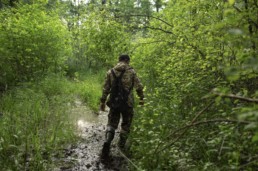
What has led to this species’ disappearance from Belarus? In the 1930s, seven thousand American mink were brought to Europe, to the former USSR for the development of the fur trade. The American mink settled into its new landscape very well and soon began to outcompete the native European mink. Several decades later local hunters stopped seeing European mink. It remains unclear whether the species has now become extinct in the country.
Dmitry Shamovich , a zoologist and expert from the Polesia – Wilderness without borders project, set up 25 camera traps along the Stviga River and its tributaries in the hope that a European mink would be detected. Since minks are semi-aquatic animals, the camera traps were set up right next to the river and on drainage canals.

Dmitry explains that the European mink are not very mobile and usually do not venture further than a kilometre from watercourses. Some camera traps were also installed in the water, on metal and birch pegs, while others were fixed on trees on the river bank. Several weeks later the team returned to the Stviga by boat to collect and check the cameras.

On the shore, Viktar Fenchuk , an APB-Birdlife Belarus specialist and program coordinator of the Frankfurt Zoological Society in Belarus, explained:
“Stviga is the main water course of the Almany Mires Nature Reserve. Among the tributaries of the river there are many reclamation canals, which, although they are in a dilapidated state, still discharge water from the swamp, draining it.”
The project aims to strengthen the conservation status of the reserve. Wildlife is almost untouched here; there are very few places like this left in Europe. In addition, project specialists also monitor drained areas in the region and plan to block drainage channels and restore parts of the mire in the future.
Sadly, the first expedition in search of European mink ended without detection of the critically endangered species. The team will return in winter to again survey the Stviga and other parts of Almany, in the hope that the mink will still be found.
Article written by Zanne Labuschagne, communications coordinator at FZS.
The project “Polesia – Wilderness Without Borders” is part of the Endangered Landscapes & Seascapes Programme and is funded by Arcadia. The project is coordinated by Frankfurt Zoological Society (FZS).
The Next Generation of Protected Areas in Polesia
The Next Generation of Protected Areas in Polesia
On the European Day of Parks we look to the ‘next generation’ of protected areas across the continent.
In central Polesia, one million hectares is already protected. This network of protected areas includes three national parks and several nature reserves and sanctuaries. In both Belarus and Ukraine, the Chernobyl Exclusion Zone – established after the Chernobyl nuclear disaster in 1986 – is largely uninhabited by people. This area now provides a refuge for many species, in particular large mammals like moose, lynx, wolf and bear. Nevertheless, many of the landscape’s most valuable areas for nature remain unprotected, while existing protected areas are often up against shortfalls in budget and capacity for effective management.
The ‘Polesia – Wilderness without borders project’, with funding from the Endangered Landscapes Programme and Arcadia – a charitable fund of Lisbet Rausing and Peter Baldwin, works to protect biodiversity and re-establish connectivity between habitats for migrating wildlife in Polesia. This is achieved through support to protected areas; the establishment of new protected areas; or through the enlargement of existing ones, on 100,000 hectares of currently unprotected wilderness. These efforts bore fruit with a 10,000 ha expansion of the Almany Mires Reserve in Belarus in 2021. Almany now spans 104,000 ha (roughly the size of Hong Kong) – securing Europe’s largest intact transition mire.
Our approach to protected area expansion is driven by science. In close partnership with protected area authorities and national scientific bodies, we plan and implement large-scale, rigorous surveys across Polesia. This work includes mapping high conservation value forests, and field camps to identify key sites for biodiversity. Camera traps are also used to survey large mammals to better understand their abundance, population dynamics and connectivity across the landscape. The project further aims to increase international awareness of the core area of Polesia by nominating it for recognition as a UNESCO World Heritage Site and Biosphere Reserve and through the establishment of cross-border Ramsar sites.
Dr. Tatiana (Tania) Kuzmenko, from the Ukrainian Society for the Protection of Birds (USPB, BirdLife Ukraine), is the regional coordinator of the ‘Polesia – Wilderness without borders’ project in Ukraine. She plays a key role in overseeing protected area expansions and nominations across the project area. We speak to Tania about her work and exciting upcoming developments for the protected areas of this part of Polesia.
Watch a short video explaining Dr Tatiana Kuzmenko’s work to expand protected areas and promote transboundary collaboration:
What does your work as regional coordinator entail?
Tania: In my role as the regional coordinator I develop a basis for the expansion and improved management of protected areas. I oversee project implementation by field research experts; organise biodiversity monitoring to collect data that guides the expansion of the protected area network; support the creation of a conservation network (protection for nests and breeding sites in forestry zones); and submit nominations for the creation of new Emerald Network sites.
Polesia already has quite a developed protected area network – why do you feel the area needs more and bigger protected areas?
Tania: Polesia is a unique region, in particular in Ukraine, in terms of conservation of wild natural areas. It is one of the most valuable natural landscapes in our country. The region mitigates global climate change through the many benefits of its well conserved rivers, wetlands, mires and forests. Currently, a significant number of valuable and unique natural territories are outside of the Emerald Network of Areas of Special Conservation Interest and others lie beyond the boundaries of protected areas. These natural landscapes are threatened with disappearing due to threats such as clear-cut, industrial logging and amber mining. Therefore, it is very important to take these areas under the protected area ‘umbrella’ as soon as possible to give them legal protection. After this first step, we need to continue our efforts to ensure that parks on the map are also adequately protected on-the-ground.
How do you go about deciding how and where protected areas should be expanded?
Tania: We have identified high conservation value areas for biodiversity, in particular outside the existing protected area and Emerald Site networks. These high conservation value areas are mapped and analyzed, allowing us to identify selected areas of significant conservation value that need to be included in the protected area network. In particular, we look for the nesting sites of rare species – thus far we have identified 119 breeding sites of Common Crane and 50 of rare owl species, amongst others, which require improved protection. To detect these species, and to better understand the space they require to thrive, we conduct special surveys, using tools including acoustic monitoring and camera trapping. So far nomination forms for 13 new proposed Emerald Network sites have been submitted to the Bern Convention committee for approval; while we are also expecting a presidential decree on the creation of the new Pushcha Radzyvila National Park (24,000 hectares).

What are the most exciting results that are on the horizon for the project’s work on protected area expansion in Ukraine?
Tania: For me this would be the initiative of local communities to create the Slovechansko-Ovrutskiy Kriazh National Park in Polesia. The creation of this protected area is a grassroots initiative from the local people themselves, who want to have this national park and develop tourism in the area. This desire is manifested in concrete actions – restoration efforts have been launched by individual communities using their own resources, and the development of future tourist routes is already underway. There is no park yet, but people are already considering building the park office. USPB, as part of the ‘Polesia – Wilderness without borders project’, have been asked by local communities to support this process by preparing a package of documents to submit to the relevant authorities for the creation of this park.
What do you see as the ‘next generation’ of parks in the Ukrainian part of Polesia?
Tania: My hope is that in the future the national parks and nature reserves of Polesia will rise to a higher level of management, with ecotourism expanded and developed in a nature-friendly way, so that these areas will be comparable to standards elsewhere in Europe. I believe that this vision is achievable, in particular thanks to the support of our project. Protected area staff are gaining experience in modern research methods like acoustic monitoring, camera trapping, the latest techniques for processing and analysis of large datasets, and the use of Geospatial Information Systems. Existing protected areas in Ukraine are currently in difficult financial conditions, the project ‘Polesia – Wilderness without borders’ has provided equipment to enhance nature conservation activities. By being involved in such an international project, protected area staff are gaining valuable experience in effective park management.
Article written by Zanne Labuschagne, communications coordinator at FZS.
The project “Polesia – Wilderness Without Borders” is part of the Endangered Landscapes & Seascapes Programme and is funded by Arcadia. The project is coordinated by Frankfurt Zoological Society (FZS).
Almany Mires Reserve Expanded
Almany Mires Reserve Expanded
Polesia’s vast Almany Mires Reserve expanded by 10,000 ha, securing habitat for threatened species.
A 10,000 hectare expansion of the Almany Mires Nature Reserve in the Belarusian part of Polesia was announced by the Republic’s Council of Ministries on March 3rd 2021. The reserve now spans over 104,000 hectares (about the size of Hong Kong) – securing Europe’s largest intact transition mire and crucial habitat for globally threatened wildlife. Together with protected areas across the border in Ukraine, it forms one of the largest natural complexes of bogs and transitional mires on the continent. The area stores huge amounts of carbon and forms part of the Pripyat river basin, playing a vital hydro-regulatory role for one of Europe’s last wild rivers.
Surveys strengthen case for expansion
The decision to expand Almany hinged on efforts by local NGOs, the Ministry of Natural Resources and Environmental Protection, and the Belarusian Academy of Sciences (NAS), supported by FZS. FZS partner APB-Birdlife Belarus has been working closely with the NAS and also the British Trust for Ornithology to carry out biodiversity monitoring and surveys in and around Almany since 2019. High conservation value forests were mapped and various field camps were completed to identify roosting trees for bats, nests of threatened birds, and other key sites for biodiversity. Acoustic recorders were deployed collecting thousands of hours of recordings and allowing researchers to identify the wildlife detected, in particular bats. Camera traps were also deployed to survey large mammals. This work, carried out as part of the ‘Polesia – Wilderness Without Borders’ project with funding from the Endangered Landscapes Programme and Arcadia – a charitable fund of Lisbet Rausing and Peter Baldwin, helped identify crucial habitat beyond the boundaries of the reserve. The preparatory work for these efforts was supported by the Claus und Taslimawati Schmidt-Luprian Stiftung Vogelschutz in Feuchtgebieten. The Belarusian Academy of Sciences submitted an expansion proposal, based on these results, to the Ministry of Natural Resources and Environmental Protection earlier this year. The proposal was accepted in March.
Watch field biologist Stas Werdal from Belarus climb high into the canopy to deploy camera traps for the study of rare Greater Spotted Eagles (Clanga clanga):
Crucial habitat for rare wildlife
Almany harbours a rich diversity of species. Large predators like Eurasian lynx and wolf roam in search of prey, which also thrive in the area; while rare birds breed in the canopy of its riparian pine-dominated forests. Listed as a BirdLife Important Bird and Biodiversity Area, the summer months see one of Europe’s rarest songbirds, the globally threatened Aquatic Warbler, and the country’s largest Greater Spotted Eagle population move into the area to breed. During this time, thousands of other migratory birds also stopover in the area to rest and build up reserves for their winter flights. Other notable species found in the area include Black Stork, Terek Sandpipers, Golden Plover, Common Crane and Great Grey Owl.
Next steps for this important heritage
Although our partners in Belarus are celebrating this fantastic result, they are determined to achieve an even higher level of protection for this special landscape. The ‘Polesia – Wilderness Without Borders’ project is preparing a bid to designate a transboundary, 250,000 hectare UNESCO world heritage site in Polesia, with Almany at its heart. Conservationists also fear that the level of protection offered by the legislation of a ‘nature reserve’ might not provide adequate protection for this unique area. They plan to apply for the highest level of protected area status in the country – Strict Nature Reserve – which would better protect Almany’s forests from exploitation.
Article written by Zanne Labuschagne, communications coordinator at FZS.
The project “Polesia – Wilderness Without Borders” is part of the Endangered Landscapes & Seascapes Programme and is funded by Arcadia. The project is coordinated by Frankfurt Zoological Society (FZS).
Polesia: a vast wetland wilderness
Polesia: a vast wetland wilderness
The world’s wetlands are disappearing three times faster than its forests, with 90% lost since the 1700s. These vanishing ecosystems play a crucial role in storing and cleaning water, mitigating flood damage, sustaining biodiversity, providing us with food and storing huge amounts of carbon.
Protecting wetlands
Polesia is Europe’s largest wetland wilderness and greatest floodplain region. Some of the continent’s last ‘wild’ rivers meander across the landscape, through a vast patchwork of carbon storing peatlands and forests, islands, lakes, bogs and wet meadows. Stretching across Belarus and Ukraine, spreading into Russia in the East and Poland in the West, Polesia covers more than 18 million hectares – about half the size of Germany. This is crucial habitat for struggling wildlife. The area harbours 60% of the world’s remaining aquatic warbler population and is the most important breeding ground west of Russia for the globally threatened Greater Spotted Eagle. Hundreds of thousands of migratory birds stopover in Polesia each year to rest, feed and breed while large mammals, like wolf, lynx and European bison, occur in significant numbers.
The ‘Polesia – Wilderness Without Borders’ project, through funding from the Endangered Landscapes Programme and Arcadia – a charitable fund of Lisbet Rausing and Peter Baldwin, is working to secure this rich natural heritage. By gaining a better understanding of the abundance and connectivity of the area’s wildlife our team are mapping priority sites. We are working with partners in Ukraine and Belarus to identify and establish new protected areas, and expand existing ones with the aim to create a contiguous network covering over 1 million hectares of ecologically functioning landscapes, including wetlands. Recognising Polesia’s global importance, the project is working on a UNESCO World Heritage Site and Biosphere Reserve nomination and driving the establishment of a cross-border Ramsar Site in Polesia. The Wild Polesia project also provides equipment and technical support to local authorities to improve the management of protected areas.

Restoring landscapes
The protection of surviving, intact wetlands is crucial, but unfortunately we have reached a point where we now need to go a step further. Altered and degraded wetlands and their vital ecosystem services need to be restored and brought back to life. Although much of Polesia’s wetlands remain largely intact and undamaged some areas have been altered. Over the coming years the Wild Polesia Project plans to restore over 6,000 hectares of mires and floodplains that were drained at the beginning of the last century.
Work has begun at the project’s first restoration site: Nerasnia in Belarus. Neresnia is a degraded transitional mire, part of the Wetland Topilovskoye, covering about 2000 hectares. This mire has been significantly altered by drainage channels and fires. These drainage channels will be blocked, in order to re-wet the mire. Monitoring hydrology, vegetation and invertebrates will help us assess and adapt our restoration efforts.
Watch FZS Belarus Programme Leader Viktar Fenchuk explain our approach:
Article written by Zanne Labuschagne, communications coordinator at FZS.
The project “Polesia – Wilderness Without Borders” is part of the Endangered Landscapes Programme and is funded by Arcadia. The project is coordinated by Frankfurt Zoological Society (FZS).
Guardians of Polesia
Guardians of Polesia
by Zanne Labuschagne
In Belarus and Ukraine local communities from Polesia are coming together to volunteer for the protection of the incredible wilderness they call home.
Local ‘volunteer caretakers’ are donating their time to protect Polesia’s reserves and key wildlife areas. The ‘Polesia – Wilderness without borders’ project, with support from the Endangered Landscapes Programme, now works with 12 volunteer caretaker teams from Ukraine and 47 volunteer caretakers from three groups in Belarus. The initiative is relatively new and as such the project continues to learn the best approach in each country and adapts accordingly. APB-Birdlife in Belarus and the Ukrainian Society for the Protection of Birds (USPB) in Ukraine are helping to guide this strategy at a national level.
Meet Anastasia
Project partner APB-Birdlife Belarus now has 47 registered volunteer caretakers in Polesia. Organised into three groups, they primarily work in the Important Bird Areas (IBAs) of Almany Mires, Mid-Pripyat and Turov Meadows. In 2020, working hand-in-hand with the caretakers, the project team organised eight workshops and community meetings to promote nature conservation and take action.
Anastasia Blotskaya, who co-ordinates the activities of one of the three APB volunteer caretaker groups, held over 150 environmental education lessons in local schools in 2020. A physical education teacher by training, Anastasia developed an extra-curricular course for local schoolchildren called ‘ABC of Ornithology’, teaching them about birds, endangered species and the importance of nature. The course is now scheduled once a week with three groups from two primary schools in the area.
Turov has been home for Anastasia and her family for the past ten years – even in that short time she has seen many changes. Anastasia is particularly concerned about lower rainfall in recent years and the resulting drop in water levels in Polesia’s rivers and wetlands. Even her young son has noticed that snowfall has become less and less each winter. Touched by the magic of Polesia, she is now working to encourage its protection within her community;
“I would very much like people to understand that material things are not as important as what nature gives us – when you breathe clean air, hear the singing of birds, the murmur of water – that’s what is valuable”.
Over-harvesting of wild berries
During the warmer months the mires and forests of Polesia become carpeted with bilberry and cranberry bushes laden with fruit. The rich abundance of berries provides important food for wildlife, but also attracts large groups of berry pickers each season. Wild berries are an important source of income for local people who pick and sell them in the summer months, but when done at scale and in the wrong places this activity becomes problematic.

One area of concern is the Almany Mires Nature Reserve in Belarus – one of Europe’s largest natural mires covering 100,000 hectares. Many species breed in the area, including the globally threatened Greater Spotted Eagle. Almany is heavily impacted by over-harvesting of berries. Pickers build illegal roads to ease access to the area, allowing for more amenities to be brought to their temporary camps. After the harvest, the land is left trampled and scattered with large quantities of litter. The breeding eagles are particularly sensitive to human disturbance and the presence of berry pickers can result in adults moving elsewhere and abandoning their chicks.
The volunteer caretakers are playing a crucial role in tackling this threat to Polesia. This year, two expeditions were organised taking volunteers into the field where they identified illegal camps and cleaned up the litter left behind. Additionally, a training on using mapping tools, including a Geographic Information System (GIS), was held to allow the teams to build up a database of camp locations and the results of field work. With the help of regional coordinators, field experts, forestry employees and the caretakers, 60 illegal berry picker camps were identified and mapped in Almany Mires and Stary Zhaden Nature Reserves this year. A map containing the illegal camps is being constantly updated and transferred to the relevant state authorities.
Meadows are overgrown
The volunteers also clear overgrown meadows near Turov in Belarus. According to ornithologist Pavel Pinchuk, who has been monitoring birds from the Turov Ringing Station for over 20 years, wader numbers across Europe are showing worrying declines. One reason for this is the lack of breeding habitat for these species. Meadows along watercourses that the birds historically used as display sites or leks, and for nesting, have become overgrown and are turning to scrub and forest due to less frequent flooding. The overgrown vegetation and lower water levels also place crucial habitat at risk for wild fires. By clearing thick vegetation from the meadows and restoring the grassland that the waterfowl require to breed, the volunteers hope to reverse this trend in Polesia.
860 kms by bicycle in Ukraine
In Ukraine, a total of 12 volunteer caretaker groups have been established, working with local partner Ukrainian Society for the Protection of Birds (USPB). Eleven of these are made up of high school students and one is a group from Zhytomyr University. These environmental enthusiasts regularly come together to monitor and protect biodiversity in the unique wilderness they call home. Although the COVID-19 pandemic hindered activities, and fewer than hoped were possible, important progress was still made in Ukraine this year.

During an 860-kilometre field trip, carried out on bicycles, eleven of the volunteer caretaker groups in Ukraine were visited. The two-week bike tour across the project area took place in July and included Wild Polesia community engagement officer, Dr Serhiy Panchenko, and a support team. During the tour the team assessed the potential for tourist bike trails in the area. Nature reserves and wildlife areas being overseen by the volunteer caretakers were also visited and inspected, and the team developed a new volunteer work plan, taking the management of many activities online due to the pandemic.
For the past six months the volunteers have also been identifying and developing ‘eco-trails’ to share the area’s natural and cultural heritage with visiting tourists. One 29-kilometre trail has already been identified in the Rivne region, while the team aims to finalise several others in the Ukrainian part of Polesia by mid-July 2021. Volunteers and young people from the local community will then be trained to guide visitors along the trails.
Across the globe young people are mobilising to fight for the protection of the planet they will inherit, theirs are some of the loudest voices advocating for climate action. The volunteer caretakers in Polesia have shown that they care for the future of their home and are willing to invest their time and effort in ensuring this important wilderness is protected.
Zanne Labuschagne is a communications coordinator at FZS.
The project “Polesia – Wilderness Without Borders” is part of the Endangered Landscapes Programme and is funded by Arcadia. The project is coordinated by Frankfurt Zoological Society (FZS).
Protecting migratory birds and their habitat in Polesia
Protecting migratory birds and their habitat in Polesia
by Zanne Labuschagne
As the season begins to turn in the vast wetlands, mires and forests of Polesia, the southward movement of several key migratory bird species has begun. Polesia is one of Europe’s largest intact wetland areas and as such is one of its most important sites for migratory birds, and in particular waders and waterfowl. Each year, in the spring, hundreds of thousands of Eurasian widgeons and ruffs as well as over 20,000 black-tailed godwits temporarily congregate in the area.
In order to effectively protect the rich abundance of life found in Polesia we need a better understanding of where biodiversity is concentrated, and the threats facing the area’s wildlife. This growing database of information is guiding our conservation actions and driving informed decisions; helping to identify areas in need of improved protection status or where to expand and better link protected areas. Behind this growing knowledge of the area is a dedicated team of experts, working tirelessly in often challenging conditions to help protect Polesia.

Turov Ringing Station, a hub for the study of migratory birds
Over 20 years ago, at the heart of Polesia, Pavel Pinchuk founded the Turov Ringing Station on the banks of the Pripyat River. An ornithologist with APB-Birldife Belarus, and a passionate naturalist, over the past two decades he has spent most of his days ringing, counting and studying the area’s birds.
Observations from Turov by Pavel and ornithologists from the Institute of Zoology (of the National Academy of Sciences of Belarus) have brought to light shifts in bird abundance and diversity in the area, information that is helping to identify ranges and threats requiring urgent conservation action. The work carried out at Turov is also helping us better understand the resource needs of species that have shown population declines. Each year a group of volunteers head to Turov to assist with ringing activities, a great example of local communities taking ownership for the protection of Polesia.
Space for Great Snipes
It was at Turov that the first tagging of Great Snipes in Belarus took place last year, providing a rare window into the fascinating migration of this threatened species. Beautifully marked with dappled stripes, Great Snipes are stocky waders that spend the warmer months in Polesia where they congregate in leks to breed. Thanks to Pavel’s efforts these important sites are now protected up to 300 meters from their centre to reduce disturbance to the breeding birds, but the latest data suggest that protecting only the breeding sites might not be enough.
Since 2019 over a hundred Great Snipes have been ringed in the area and transmitters were fitted on eleven of these by the Turov Ringing Station team providing important information on their migration patterns. Previous studies have shown that snipes will fly up to 6000 kilometres without stopping, reaching speeds up to 165 kilometres an hour. Soon after Pavel’s work at Turov was launched, a Great Snipe ringed in Polesia was detected in Gabon on Africa’s west coast – 6000 kilometres away from the site where it was originally identified. As Pavel points out, “to survive this remarkable journey requires preparation – places rich in food and with a minimum of disturbance to build up strength for their flight”. Our team is working hard to ensure that such areas exist and are preserved in Polesia.


Weaker spring floods, dropping bird numbers
Polesia is not immune to the detrimental changes that are affecting biodiversity across the globe – the past few years saw smaller than usual springtime floods with this year’s water level on average two meters lower than normal. Drier years allowed large tracts of the floodplain to burn in April last year, including one of the two known Great Snipe leks in the area. The Turov team believe that these factors might be the cause of decreasing Great Snipe numbers seen over the past few years.
Threatened Great Snipes are also being placed at risk by sport hunting when they are confused with Common Snipe, which is a game bird. Alongside Pavel’s scientific research from Turov the Wild Polesia team have also submitted recommendations to the Ministry of Forestry in Belarus to change the terms of Common Snipe hunting to avoid areas and seasons when they might be confused with their rarer cousins. In addition, historical threats like alterations to the water regime in Polesia have caused important habitat for species like snipes to be altered or destroyed. The Wild Polesia team also plans to restore over 6000 hectares of mires, which will bring large tracts of important habitat back to life.
Zanne Labuschagne is a communications coordinator at FZS.
The project “Polesia – Wilderness Without Borders” is part of the Endangered Landscapes Programme and is funded by Arcadia. The project is coordinated by Frankfurt Zoological Society (FZS).
Insect monitoring
What insects tell us about the state of Polesia's wetlands
by Adham Ashton-Butt and Corinna Van Cayzeele
Alongside our restoration of mires in the core of Polesia, we are monitoring insect communities to understand the impact of our activities on ecosystem health. Our field team has just retrieved the first samples of insects from Malaise traps installed last month.

Polesia is among the largest landscapes of natural wetlands in Europe. However, the biodiversity and stability of this ecosystem complex suffers from the draining of mires. Drainage channels that were dug for the so-called “reclamation” of land for agriculture during Soviet times continue to drain large parts of Polesia’s wetlands. The drained mires make the area less resilient to droughts and fires and eliminate important ecological processes and habitat. Part of our project, therefore, is the restoration of 6,000 hectares of drained mires in the core area of Polesia.
But how do we know where restoration is needed and whether it has the desired effects?
To ensure that our activities benefit all aspects of the ecosystem, we need sound ecological knowledge. More specifically, we need data on insects. Insects are excellent indicators of ecosystem health as they are very sensitive to environmental change and respond quickly to disturbances or restoration, due to their short lifecycles. Therefore, certain assemblages of insects can be associated with different habitats, or different states of ecosystem health.
They are also at the heart of food webs that sustain the ecosystem, providing sustenance for birds, bats and small land mammals. We are looking at numbers and composition of insects to better understand
- the importance of undisturbed habitats,
- the impact of drainage, wildfires and seasonal changes, and
- The effect of our restoration activities on mire ecosystems.
In May, our field team started installing Malaise traps (tent-like structures that capture insects) to sample flying insects. The traps are being installed in near-pristine mires, drained mires (from heavily drained to slightly drained), restoration sites and sites affected by fire. We expect to catch mostly Hymenoptera (bees and wasps), Diptera (flies and relatives), Lepidoptera (moths and butterflies), some Odonata (dragonflies and damselflies), Ephemeroptera (mayflies) and some small Coleoptera (beetles).
Last week, the ecologists started collecting the first samples that had been caught. And with this starts the tricky part: species identification. Having specialist taxonomists identify each individual would be very time consuming. Moreover, many insects, especially many flies, have not yet been classified to species level. Therefore, identifying large numbers of samples across broad taxonomic groups is very difficult, if not impossible.

We are largely resolving this problem by using DNA metabarcoding to identify insects. DNA will be extracted from insect samples, sequenced to reveal its genetic code and identified by comparing against freely available genetic libraries. Some species will still not be able to be identified to species as their genetic code has not been stored in DNA libraries. However, these species can still be differentiated from one another genetically and can be labelled as “Species A” or “Species B”. This way, the presence of these species can still be compared across samples and sites. The biomass of each sample will also be measured, in order to compare the abundance of insects present between sites.
Sampling will continue over the next four years. Over this period, we will be able to analyze the response of insects to changes while taking into account different weather conditions between seasons and years. For example, it may be that in “good” years with cold winters and large spring floods, insect communities do not differ much between natural and drained sites. However, in years of drought, they might change more in sites that are degraded, as those sites do not have the environmental buffers provided by a “healthier” ecosystem.
Besides monitoring the effect of restoration, this study will help predict the consequences for biodiversity if draining is not stopped. We may lose certain types of insects and, consequently, associated plants and larger animals that depend on them for food and pollination. We will know the results after these four years. In the meantime, we will start blocking drainage channels to rewet mires and adjust our activities according to our findings along the way.
Dr. Adham Ashton-Butt is a Senior Research Ecologist at the BTO. Corinna Van Cayzeele is a Communications Assistant at FZS.
The project “Polesia – Wilderness Without Borders” is part of the Endangered Landscapes Programme and is funded by Arcadia. The project is coordinated by Frankfurt Zoological Society (FZS).
